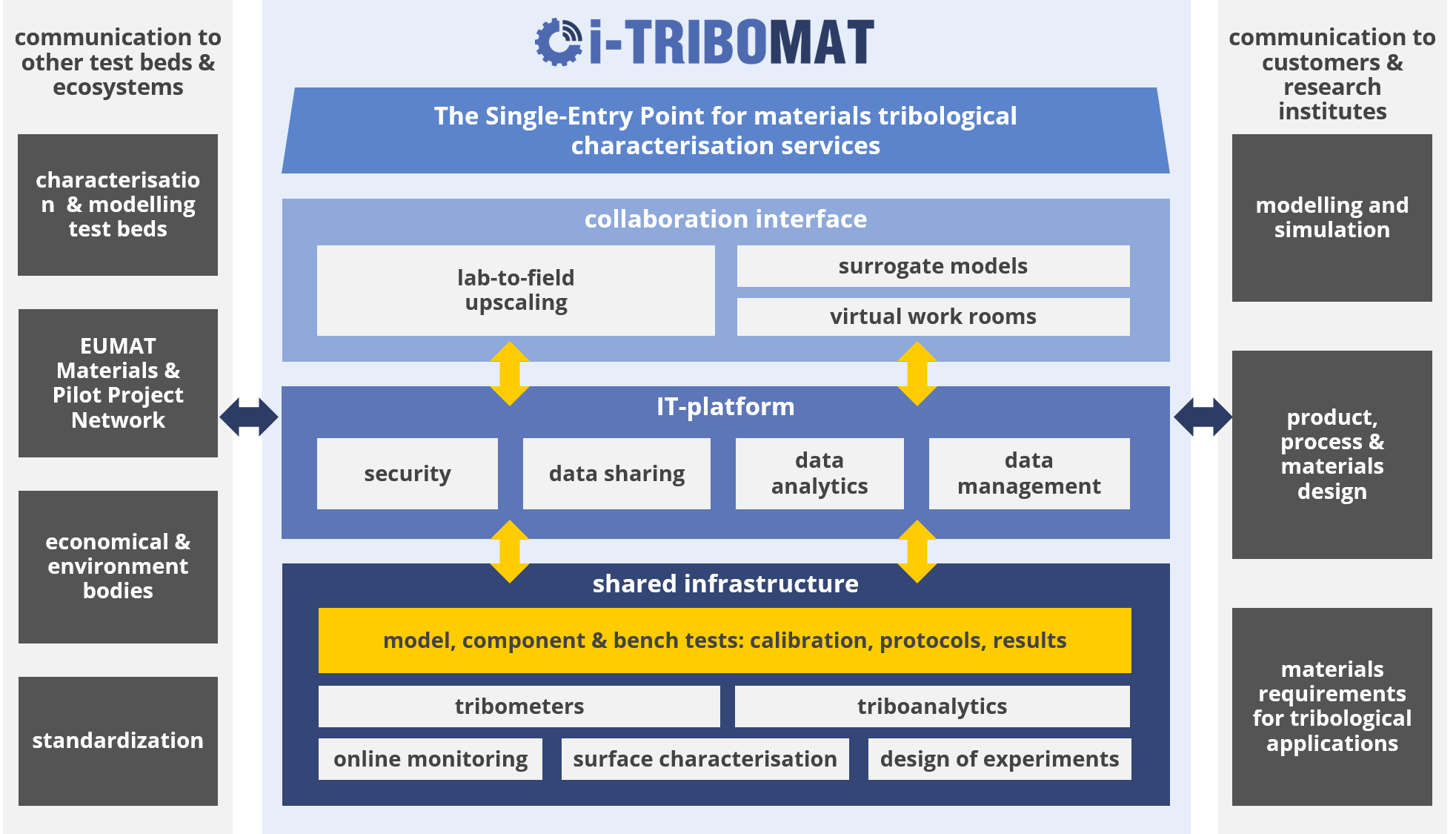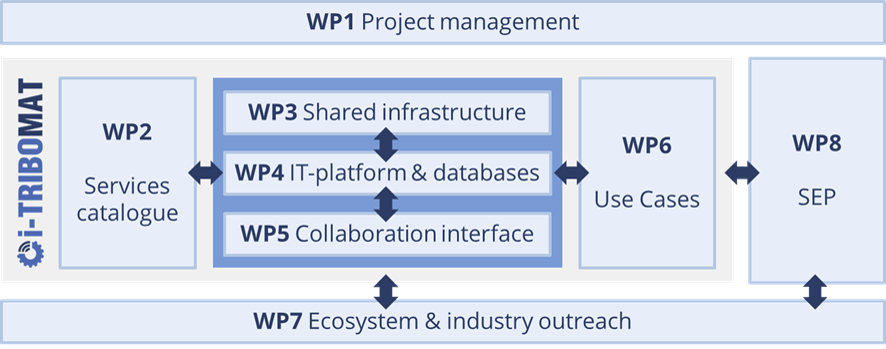i-TRIBOMAT will provide the world’s first Open Innovation Test Bed dedicated to validating and up-scaling new materials, thereby enabling intelligent Tribological Materials Characterisation and fostering industrial innovation in European manufacturing industry.
The main concept:

Implementation - work package structure:

WP1 - Project Management
Objectives:
WP1 will ensure seamless project workflow and provide the necessary support for the other WPs. Main Tasks within this project are project coordination and reporting, project communication, dissemination planning, and risk management.
Contact: www.ac2t.at
WP2 - Service Catalogue
Objectives:
The main objective of WP2 is the development of customer-oriented services incuding operating procedures, new standards, materials characterisation, data integration and data management as the inputs for WP3, WP4 and WP5. Additionally complementary data-driven services will be defined in the WP.
Contact: www.tekniker.es
WP3 - Shared Infrastructure
Objectives:
WP3 consolidates the shared infrastructure owned by the consortium members under the i-TRIBOMAT umbrella by:
- compiling the infrastructure for tribological material characterisation and tribo-analytics
- establishing protocols for data transfer from the infrastructure to the IT-platform
- designing and implementing device-specific procedures, best practices, and standards to ensure the validity, reliability and replicability of the tests
Contact: www.tekniker.es
WP4 - IT-Platfrom & Database
Objectives:
In WP4, the required interfaces are developed and all data are collected and stored. The OITB will have the possibility to integrate data from other OITBs or European initiatives, as demonstrated by the integration of data from end users (WP2), shared infrastructure (WP3) and collaboration interface (WP5) within the project. The detailed objectives of WP4 are the:
- establishment of a central materials database platform including
- data generated during tribological materials characterisation,
- existing material data (material properties, sample history), and
- data generated before and after tribological materials characterisation (tribo-analytics).
- orchestration of all SEP services using the IT-platform by providing a web-interface (portal) to the end-users,
- access via digital interoperability to other initiatives (e.g., OITBs, Market Place projects, EMCC and EMMC initiatives, reference data such as NOMAD and TRIDAS)
- applications to specific analytical tools, notably up-scaling via the Collaboration Interface (digitization of materials and characterisation).
- secure data storage, access and exchange
Contact: www.grantadesign.com
WP5 - Collaboration Interface
Objectives:
The Collaboration Interface enables transfer of experimental results between the test scales by model-based approach. The interface also provides means for collaborative model building between stakeholders and dissemination of results to customers, such as product design engineers and materials modellers. The objectives related to this WP include the following:
- Model-based Lab-to-Field up-scaling tool for materials will be generated and validated to decrease the number of expensive component and higher scale experiments.
- Scale jump to bridge the gap between the model and the component tests will be accomplished by using Lab-to-field up-scaling tools to achieve the most cost-effective materials up-scaling
- Experimental measurement data and materials data collected through the IT-platform (WP4) will be utilised in the parametrisation of the simulation models to produce optimised design parameters and large-scale materials property predictions
- Fast-to-compute surrogate-type models will be generated and integrated into the model chain of Lab-to-Field up-scaling tool using, inter alia, Machine Learning (ML) methods
- Virtual work rooms will be generated to support collaborative model building as well as for the result dissemination to customers as easy-to-use web applications. Exemplary web-apps will be built for the Use Cases in WP6
Contact: www.vttresearch.com
WP6 - Use Cases
Objectives:
At least three Use Cases will demonstrate the innovative approach of materials up-scaling by utilizing i-TRIBOMAT services as defined in WP2 and elaborated in WP3, WP4, and WP5. The objectives are
- validation of i-TRIBOMAT services for materials up-scaling, such as
- synchronisation of the entire shared infrastructure
- compilation of obtained data into the i-TRIBOMAT database
- performance of the collaboration interface “from laboratory tests to field applications”
- demonstration of versatility of i-TRIBOMAT services (low-medium-high loading and sliding conditions)
- innovation of
- Lab-to-Field up-scaling tool demonstrated by UC 1
- prediction of macroscopic properties using AI methodologies demonstrated by UC 2
- online tools for tribological materials characterisation demonstrated by UC 3
Contact: www.ltu.se
WP7 - Ecosystem & Industry Outreach
Objectives:
WP7 will ensure effective stakeholder engagement with and between all relevant players of the European Advanced Materials Development Ecosystem. Accordingly, the Translators Network and External Advisory Board – representing the value-driven community in this WP – will be constituted to contribute to following main objectives by:
- exploiting ecosystem engagement and multiplier effects through the European Advanced Materials Development Ecosystem to promote open innovation among the players, especially SMEs
- creating awareness of i-TRIBOMAT by customer-oriented SEP communication and dissemination, e.g., including tribology courses for SMEs’ staff members
Contact: www.tekniker.es
WP8 - SEP - Single Entry Point
Objectives:
The final objective of the project is to create and establish i-TRIBOMAT SEP – a sustainable new legal entity operating i-TRIBOMAT Open Innovation Test Bed. WP8 will include the following activities: the definition of value proposition, the market and competition analysis, and the characterisation of the configuration of the value creation (partners, value chain, customer relationships, etc.). Based on these economic analyses will be performed to evaluate the profitability of the revenue model, understand future cash flows and highlight the need for additional funding or external investment to reach the first sales. All investigation results will be summarised in the comprehensive business plan. This WP handles following key issues:
- SEP Legal Form & Stakeholders definition.
- SEP Governance model
- SEP Business Model & Business Plan
- SEP Marketing plan
Contact: www.ac2t.at
Downloads
Project Brochure

Here you can download our i-TRIBOMAT project brochure as a PDF file:
Project Brochure PDF Download
Go to top